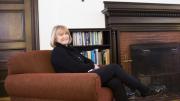Harvard Law School is dismantling its library in Langdell Hall in preparation for a major remodeling of the building. "We had to decide whether to remodel piecemeal or all at once," says Harry Martin, librarian and professor of law. "Piecemeal would have taken four years and cost more money. So we decided to do it in one fell—intense, unpleasant, but shorter—swoop."
A passerby right now would discover a significant hole in the ground, with pilings, next to Langdell on the quadrangle side, and might surmise that the Law School was erecting a mini-wing. Not so. Because some small parts of the building will not be remodeled and will continue to operate throughout the crashing and banging, workers are first building a new power substation to serve those sections before trashing the old electrical system.
Construction will begin in earnest, with regular double shifts for speed, on the Monday after Commencement in June. The library will reopen by Labor Day in 1997, having by then been transformed into what Martin calls "the world's premier center for legal information." The construction cost of the remodeling: $22 million. The project cost: $33 million. The architects: Shepley Bulfinch Richardson and Abbott, the firm that designed the original building. Before the construction may begin, the books—and the oil paintings, the statues, the antique furniture, and the people—must be removed. Of the 800,000 books in Langdell, some 300,000 rare ones will be protected in a part of the building that will not be renovated. Another 250,000 will journey to the Harvard Depository in Southborough, Massachusetts, for storage. A core collection of 200,000 books will move to rented space in East Cambridge, to be joined by 65 back-office people—book orderers, catalogers, and the like. Finally, librarians will commandeer almost all the public-function space in Pound Hall, including the faculty dining room, to establish a temporary 50,000-volume reference and reserve collection. Martin's belief is that the inconvenience of all this will be bearable because brief. "It's a huge amount of upheaval," says administrative librarian Cathleen Conroy, "but the building will be terrific when we move back in."
The primary goal of the project is not to increase capacity for seating or for books, but to add technology. The library, which sometimes gets so hot that the ceiling lights have to be turned down, will henceforth be air-conditioned. No more sweating over one's studies. A vast new electrical system will be in place, and none too soon. The first part of Langdell was erected in 1905, the newest parts are 68 years old, and many of the present electrical arrangements have been humming along far longer than anyone had a right to expect. Speaking of expectations, when the Law School class of 2000 enters the new facility, it will find—as it no doubt would expect—that each of the 700 seats in the library is wired for access to legal databases such as Lexis/Nexis and Westlaw and to the Internet.
The library will annex a former classroom and faculty offices vacated after the opening of Hauser Hall and agreeably reconfigure its internal spaces. The architects in 1905 intended the library to resemble a nineteenth-century German one, Martin explains, with a big reading room at the top and closed stacks below. Officials decided to go to an open-stack system 35 years ago, but all the passageways and stairwells remained mean and narrow as designed, suitable only for a few scurrying stack boys. That will change. "New stairs and elevators will open the building up," says Martin. "When you enter Langdell now, you're in a lobby and have to go up three floors to find the reading room. When you enter in future, you will be in the library straightaway. There will be better integration of seats and books, with more seats in the stacks and more stacks in the reading room. There will be comfortable lounge seating and more carrels for privacy."
According to Paul Upson, assistant clean for finance and operations, plans for the overhaul of the library have been under development since the early 1980s, when the school considered a more modest scheme by different architects. Part of the program then, as now, was to build an aerial passageway to Langdell from the International Legal Studies library in an adjacent building, and the earlier scheme was controversial partly because the connector it proposed seemed to some people to be an eyesore.
Apart from a new, non-eyesore connector and wheelchair ramps, the exterior of Langdell will not change in appearance. Workers will rip the ivy from the walls to unclutter the windows, but will not intentionally kill the roots, says Upson. Still unresolved: whether to let the ivy grow back.





